2010 Polaris 600 Dragon Switchback Review

The nearly perfect flatlander's boondocker
For 2010 Polaris proved adept at maximizing chassis and engine combinations, especially in the “crossover” segment, where there’s a base model, a luxury version and full-on sport setup. This stretch-track niche is where trail sleds meet powder sleds, but come up a bit short of the mountain segment. However, these sleds are about ideally suited for flatlanders to get off-trail and go boondocking. These are what we’ll call occasional powder sleds because they’ll be used as much on the trail as they are off of it.
For those of you with long memories, you’ll recall that Polaris pretty much invented this segment when it fitted its trail sport Indy with a longish track to give its trailing arm model better flotation and traction in western powder. That evolution to today’s mountain sleds saw the Snow King Special (SKS) and Rocky Mountain King (RMK) become powder-specific designs with the flatland model actually scheduled to die out. That plan never went forth as Ski-Doo created its own flatland off-trail specialty sled. Adding a stretch track Renegade version of the Ski-Doo MX rejuvenated this segment. Seeing Ski-Doo’s success, Polaris rejiggered its design and named it the Switchback. And, voila, here we are today with an incredible number of powder choices from a basic Switchback with its 136-inch track up to an 800 Dragon RMK 163 with a humongous 13.6 foot rubber band under it that floats it through deep mountain powder.
Flatland Use
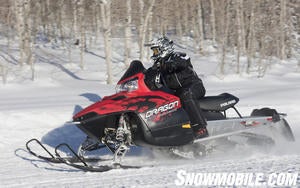 Good off trail, the Dragon Switchback is equally adept on groomed trails.
Good off trail, the Dragon Switchback is equally adept on groomed trails.
For flatland usage, you might as well blow past the luxury stretch track LX versions, forget the base model and choose the Dragon with either the latest Polaris 800cc Cleanfire Twin or the more than satisfactory Cleanfire 600 Twin. We choose the 600. When we test ride the 600 motors at altitude in places like Grand Lake, Colorado, we tend to forget that these engines lose a significant percent of power at 9,000 to 11,000 feet. Back home at sea level, that power comes back and we find ourselves going, “Huh! Where’d that power come from?”
Polaris’ Cleanfire 599cc fuel injected Twin makes 120-plus horsepower in the flatlands of the Midwest. It’s perfectly adequate for off-trail riding. If you absolutely have to have extra power and want to pay for it, there is an 800cc Switchback as well. Regardless of the engine choice, we’d say if you are a serious flatland boondocker, go for the Dragon Switchback. Don’t even think twice about it. The Walker Evans shock upgrade gives you suspension tuning options and a quality package that is worth the extra cash. Except for the power difference, the two Dragon options are quite similar.
New Favorite
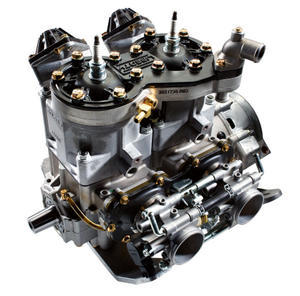 The latest Cleanfire 600 is Polaris designed and built.
The latest Cleanfire 600 is Polaris designed and built.
The 120-plus horsepower, 600cc Cleanfire Twin has become a new favorite. We have been steadfastly loyal to the Rotax 600s that power the Ski-Doo models, but our time with the Polaris-designed and engineered 600 has changed our mind. We feel that the Polaris seems more responsive to the throttle and runs more crisply than the Rotax 600 semi-direct engines. We may revert to the Ski-Doo side once we spend more time with the latest 600 E-TEC motor, but we won’t say that’s a given. The Cleanfire engine that Polaris has on the snow now, is pretty impressive. The 600 seems to be a strong runner from low to midrange to top end. We are very pleased with the performance we’ve gotten to date. Running off trail means you need a powertrain that responds quickly and positively to throttle input — or you can be shoveling yourself out of a bad spot.
Unlike mountain powder, off-trail flatland powder can easily be a trap of fresh, unbroken snow covering bent over brush that offers no traction. You want your sled to be able to power away from this trap quickly and without trenching into the bottomless snow. You also need a powertrain that lets you move slowly off trail and chassis that lets you pull the nose up and over downed trees lying crosswise in your path.
Mountain Heritage
Since Polaris invented this segment of riding, it is reassuring to know that the Switchback claims a strong powder heritage. Backing up that heritage are mountain styled pieces that give this flatland player an added edge in untracked snow.
The narrow Dragon seat lets you stand up to maneuver through bumps and to dance runningboard to runningboard off trail. There’s a flat handlebar design mounted on a 5.25-inch riser to keep the control in your hands. The flexible mountain strap lets you pull the sled over in deep snow so you can ride hanging out off the side.
The Dragon comes with the latest lightweight and narrowed front end to add off-trail nimbleness. The Dragon Switchback IQ front suspension gives you 10-inches of travel that you can tune as you like. Exclusive to Polaris Walker Evans adjustable piggyback compression adjustable shocks can be suited to your needs. The Dragon Switchback features Walker Evans shocks on the coupled parallel slide rail suspension, too. The rear suspension’s front arm uses a Walker Evans shock with an internal floating piston while the rear arm adds an adjustable Walker Evans design shock to maximize ride comfort.
Rip Saw Traction
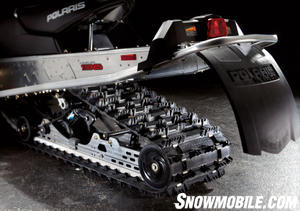 The 136-inch Rip Saw track features 1.25-inch lugs for powder grip.
The 136-inch Rip Saw track features 1.25-inch lugs for powder grip.
The Cleanfire engine and IQ rear suspension work with the 136-inch Rip Saw track to get the most traction off trail that is possible. Add in the full 15-inches of track width and 1.25-inch lug profile and you have a traction setup that works well on groomed trails or whenever you choose to break away from the pack and go exploring off trail. The 600 Dragon Switchback leaves the choice to you — but all the while giving you the knowledge that you can ride in control wherever you choose.
On trail the 600 Dragon Switchback uses its longer track to bridge bumps. The saddle lets you move easily for cornering as the IQ front plants the plastic skis firmly in the turns. Here you can “roll-on” the power as you exit turns. This 600cc Twin likes to pull and you’ll feel it off the turns. Of course, we like the fact that the Polaris 600 Dragon Switchback comes with a very positive feeling hydraulic disc brake. We do make mistakes from time to time.
We also like the Polaris electronic reverse, which lets you back off a trailer by simply pushing a handlebar mounted button. The Dragon Switchback comes with a digital gauge, a stylish — but low — matte black windshield, 11.5 US gallon capacity fuel tank and standard j-hook ends on the handlebar. All in all, the added US$700 that the Dragon version adds to the basic Switchback seems marginal for serious flatland boonie bashing. If you insist on more power the 800cc version will cost another thousand bucks. If you travel to altitude, we can see the value of such an upgrade, but for most sea level riding, we bet you’ll find the 600 Cleanfire all you need.
| 2010 Polaris 600 Dragon Switchback | |
| Engine | Polaris Liberty 599cc Twin cylinder 2-stroke; liquid-cooled; Cleanfire fuel injection |
| Horsepower | 120-plus |
| Drive | Polaris P-85 drive; P2 driven |
| Front Suspension | Polaris IQ — 10-in maximum travel; Walker Evans piggyback compression adjustable shocks |
| Rear Suspension | Polaris IQ 136 Coupled slide rail; Walker Evans IFP gas shock on front arm and Walker Evans compression adjustable sock on the rear arm |
| Length | 120.0 in |
| Width | 48.0 in |
| Height | 48.5 in |
| Ski Stance | 42.5 in |
| Track | 15 x 136 x 1.25 Rip Saw |
| Weight | 502 (claimed) |
| Brake | Polaris hydraulic |
| Features | Electronic reverse (PERC) |
| Fuel Capacity | 11.5 US Gal |
| MSRP | US$9,799.00 |
Related Reading
2010 Polaris 700 & 600 RMK Review
2010 Polaris RMK, Dragon & Assault Review
2010 Polaris Turbo LX Review
2009 Polaris Turbo Switchback Review
All Things Polaris on Snowmobile.com



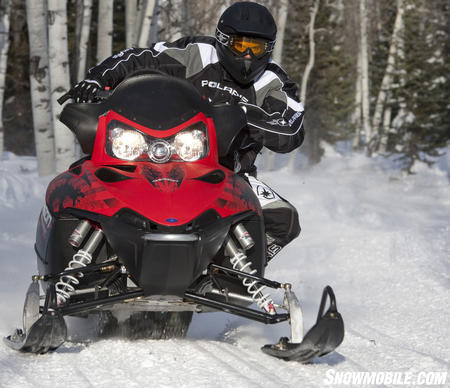
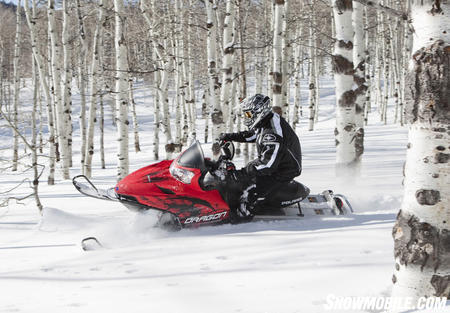
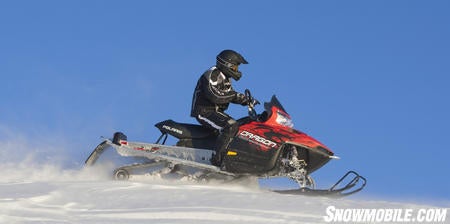
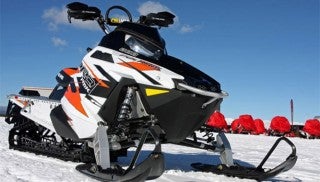




 Your Privacy Choices
Your Privacy Choices